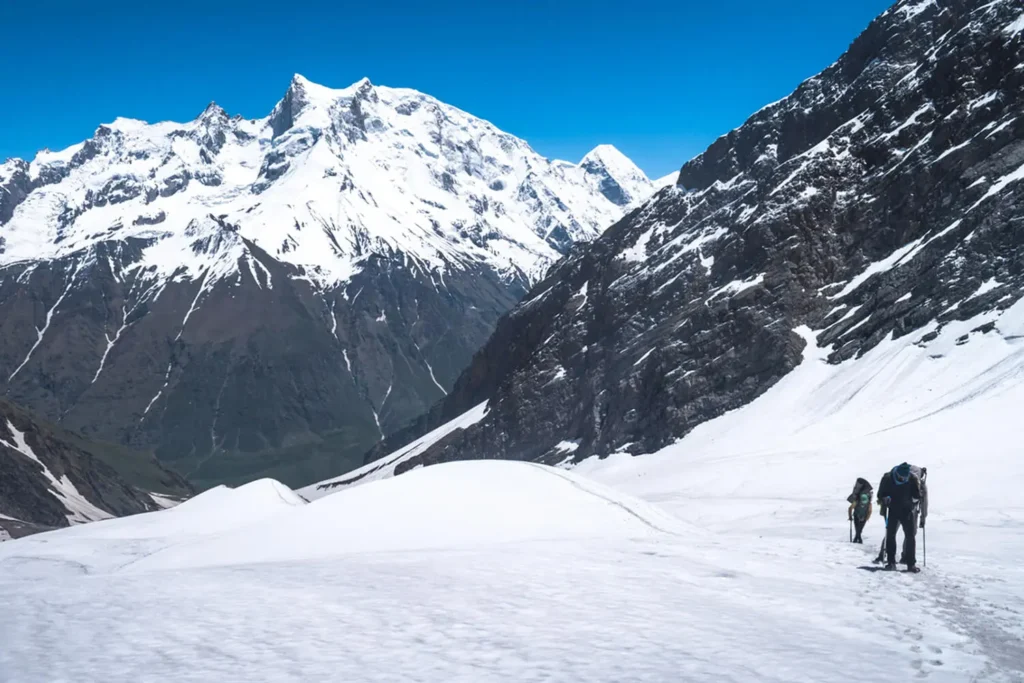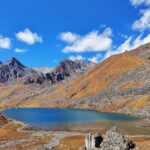Bali Pass Trek has two distinct seasons with favourable weather and moderate temperatures. Bali Pass temperature in the summer months of May and June is mild and comfortable. The season boasts a clement weather featuring bright and warm days. September to October also feature pleasant weather and manageable temperatures.
Here’s a detailed guide to Bali Pass trek weather, helping you choose the best time for trekking on this adventure-filled Himalayan trail.
Bali Pass Monthly Temperature Details
| Season | Month | Minimum Temperature | Maximum Temperature |
| Winter | January | -18°C | -7°C |
| Winter | February | -15°C | -5°C |
| Spring | March | -10°C | 0°C |
| Spring | April | -4°C | 13°C |
| Summer | May | -4°C | 17°C |
| Summer | June | -3°C | 14°C |
| Monsoon | July | 6°C | 18°C |
| Monsoon | August | 10°C | 20°C |
| Autumn | September | -4°C | 14°C |
| Autumn | October | -5°C | 12°C |
| Autumn | November | -6°C | 10°C |
| Winter | December | -7°C | 8°C |
Bali Pass Temperature in May

May marks the beginning of the trekking season in Bali Pass. Temperature in May remains pleasant during the daytime with warm and sunny days. The day temperature ranges between 12°C to 17°C. The nights are chilly, and the cold increases as the temperature drops. The average night temperature in Bali Pass is recorded at a minimum of -4°C – 0°C.
Bali Pass weather is favourable in May. However, the weather keeps fluctuating as you climb to higher elevations. Prepare for a drop in temperature at the higher campsites.
Bali Pass Temperature in June
The temperature in June is endurable with warm and sunny days. The day temperature in June is recorded between 10°C to 14°C in Bali Pass. At night, the temperature hovers around 0°C to – 3°C.
Bali Pass Temperature in July
Bali Pass in July is not suggested as it is a peak monsoon season. The region receives incessant rain. It becomes difficult to navigate owing to the constant rain. The campsites are not in manageable conditions, and the place also has a risk of landslides during July when the monsoon picks up in Himachal and Uttarakhand.

The average maximum temperature in July is 16°C to 18°C during the daytime. The minimum temperature is recorded at around 5°C to 6°C during the night.
Bali Pass Temperature in August
Much like July, August witnesses heavy rainfall in Bali Pass. Due to heavy rains, the trail becomes slippery. It becomes challenging to pitch a tent, and there is also a risk of flash floods when it rains incessantly. The days remain cloudy and the trail becomes landslide prone for trekking in August.
August registers temperature between a minimum of 10°C to a maximum of 20°C.
Bali Pass Temperature in September
Autumn season starts in September and continues till mid-October. September temperature tends to sit between 12°C to 14°C during the daytime. The nights can become extremely cold with freezing temperatures. At higher campsites, temperatures can dip to zero degrees in autumn. The minimum temperature drops to -4°C to -5°C at higher campsites.
The best part of trekking to Bali Pass in September is clement days, clear blue skies, and tolerable temperatures. The monsoon clouds do not hover, and there is a crispness in the air.
Bali Pass Temperature in October
The Bali Pass weather in October is a bit colder than in September. The temperature in October is usually recorded between 8°C to 12°C during the day. At night, the temperature drops to 0°C. At higher campsites, expect the temperature to reach the lowest of -6°C in Bali Pass.
The October weather in Bali Pass remains clear during the day. However, the daylight hours are shorter, you will experience a chill in the air. There is a high probability of snowfall in Bali Pass by October end.
Bali Pass Temperature in Winter (December to February)
Winter season begins in Bali Pass in December and continues till early March.
Bali Pass weather in winter is unforgiving. Temperatures drop to levels that make trekking uncomfortable and challenging. The average winter temperature in Bali Pass is recorded between 0°C to -18°C.
The heavy snowfall in the region makes it difficult to navigate the trail. It becomes challenging to attempt the Bali Pass trek in winter due to extreme weather conditions and unbearable cold.
Bali Pass Temperature in Spring (March and April)
Bali Pass weather in the spring season is harsh and extreme. The snow on the trail in spring months makes it challenging to navigate the higher campsites.
Bali Pass Temperature in March
March in Bali Pass has a maximum of 7°C during the day to a minimum of -12°C in the morning and night.
Bali Pass Temperature in April
The Bali Pass trek in April registers a slight increase in day temperatures. April temperature ranges between 10°C in the daytime to min -5°C at night and early mornings. April has warm and sunny days featuring clear weather and magnificent views of the big mountains.
Bali Pass Trek Highlights
Bali Pass trek connects Harki Dun Valley to Yamunotri and takes you to an altitude of 16, 420 ft. Categorized as a difficult trek, Bali Pass demands extreme physical fitness and determination to summit the Pass. Bali Pass is apt for trekkers who long to unravel the unexplored train in the Himalayas. The trek starts in a village called Sankri in Uttarkashi.
It takes nine days to complete the trek, including travel to and from the base camp.
You will cover a total distance of around 55 km. Bali Pass trek demands you to be physically fit. Trekkers face tricky ascents, challenging terrains, and a heart-thumping pass-crossing experience on this exhilarating crossover trek.
The beauty of the Bali Pass trek is unmatched. It opens a buffet of splendid meadows, the unparalleled beauty of Ruinsara Tal, and the captivating valley of Harkidun. Add the grandeur of the Himalayas, as you will be mesmerised by the mighty peaks of Bandarpooch, Kalanag, and Swarohigini.





